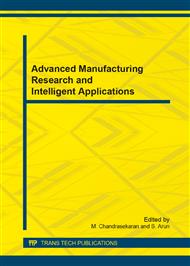p.72
p.77
p.81
p.85
p.89
p.94
p.98
p.103
p.108
Abrasive Assisted Electro Chemical Machining of Aluminum-Boron Carbide-Graphite Hybrid Composite
Abstract:
In this paper, attempts have been made to model and optimize process parameters in Abrasive assisted Electro-Chemical Machining (AECM) of Aluminium-Boron carbide-Graphite composite using cylindrical copper tool electrodes with SiC abrasive medium. Optimization of process parameters is based on the statistical techniques with four independent input parameters such as voltage, current, reinforcement and feed rate were used to assess the AECM process performance in terms of material removal rate. The obtained results are compared with without abrasive assisted electro chemical machining of Aluminium-Boron carbide-Graphite composite. Abrasive assisted ECM process exhibited higher material removal rate from composite material when compared with without abrasive assisted ECM.
Info:
Periodical:
Pages:
89-93
Citation:
Online since:
July 2014
Authors:
Price:
Сopyright:
© 2014 Trans Tech Publications Ltd. All Rights Reserved
Share:
Citation:


